January 2025
The global telecom tower market size is calculated at USD 67.87 billion in 2025 and is forecasted to reach around USD 165.61 billion by 2034, accelerating at a CAGR of 10.42% from 2025 to 2034. The Asia Pacific market size surpassed USD 27.66 billion in 2024 and is expanding at a CAGR of 10.54% during the forecast period. The market sizing and forecasts are revenue-based (USD Million/Billion), with 2024 as the base year.
The global telecom tower market size was estimated at USD 61.46 billion in 2024 and is predicted to increase from USD 67.87 billion in 2025 to approximately USD 165.61 billion by 2034, expanding at a CAGR of 10.42% from 2025 to 2034. The growth of the market is driven by surging demand for high-speed connectivity, 5G expansion, and the increasing reliance on digital communication networks.
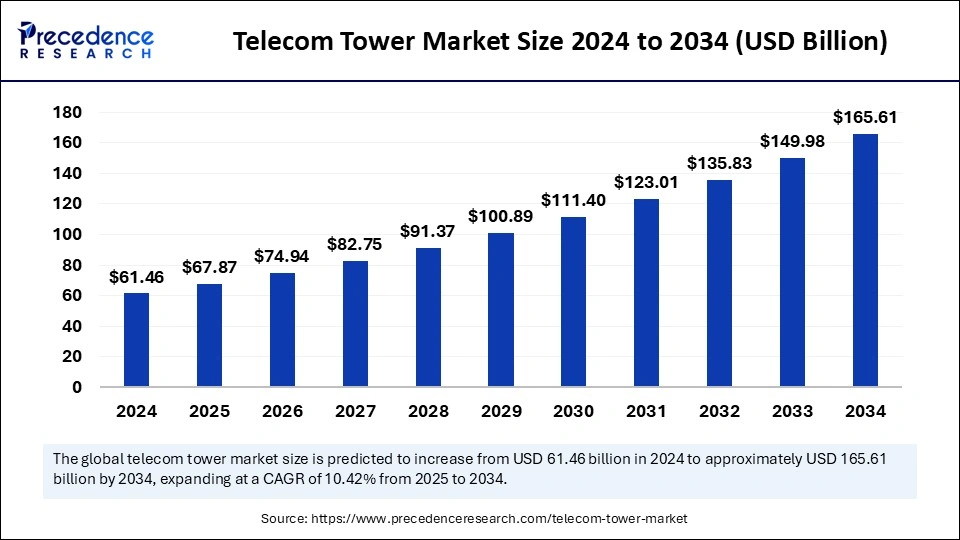
Artificial Intelligence-driven predictive maintenance is revolutionizing telecom tower operations by lowering repair costs and downtime. Advanced analytics is used to continuously monitor sensor and Internet of Things (IoT) device data to identify early indicators of equipment failure. This enables operators to resolve possible problems before they result in outages. Integration of smart power management systems improves telecom tower energy efficiency. AI optimizes energy use and smoothly switches between renewable energy sources such as wind and solar. One of the biggest infrastructure suppliers in India, Indus Towers, has effectively reduced waste and carbon emissions by implementing energy optimization strategies. AI also helps with network traffic management and security. Even at peak times, seamless connectivity is ensured by AI-driven traffic management solutions, which dynamically modify bandwidth in response to demand. Telecom towers are also more secure than ever due to automated threat detection enabled by AI that deter theft and vandalism.
The Asia Pacific telecom tower market size was exhibited at USD 27.66 billion in 2024 and is projected to be worth around USD 75.35 billion by 2034, growing at a CAGR of 10.54% from 2025 to 2034.
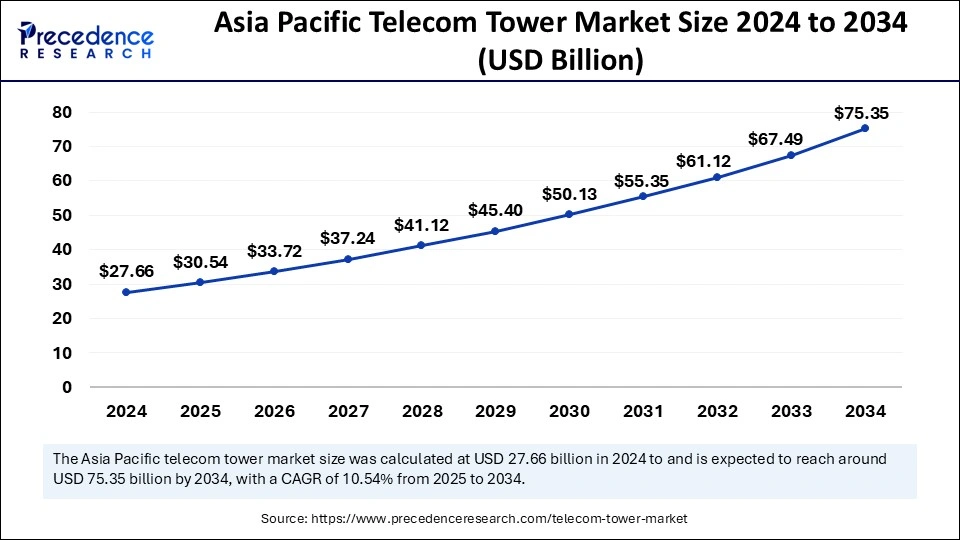
Asia Pacific dominated the telecom tower market by capturing the largest share in 2024. This is mainly due to the widespread 5G deployments and expansion of mobile connectivity. To accommodate rising data consumption and digital transformation, nations like China, India, and Indonesia are improving their telecommunications infrastructure. Governments around the region are promoting digitization, requiring robust telecom infrastructure. Continued investments in smart city initiatives, the rise in demand for reliable connectivity options, and the heightened need for telecom services further bolstered the market in the region.
North America is seen to grow at the fastest rate in the upcoming years. This is mainly due to the growing need for 5G and high-speed internet. The U.S. is expected to have a stronghold on the North American telecom tower market due to rising investments by telecom operators to increase their tower network. Acquisitions of communication sites are strengthening network coverage. To guarantee smooth connectivity for next-generation digital services, tower installations are being expedited by deploying small cell technology in urban areas. The rising demand for wireless network connectivity further contributes to regional market growth.
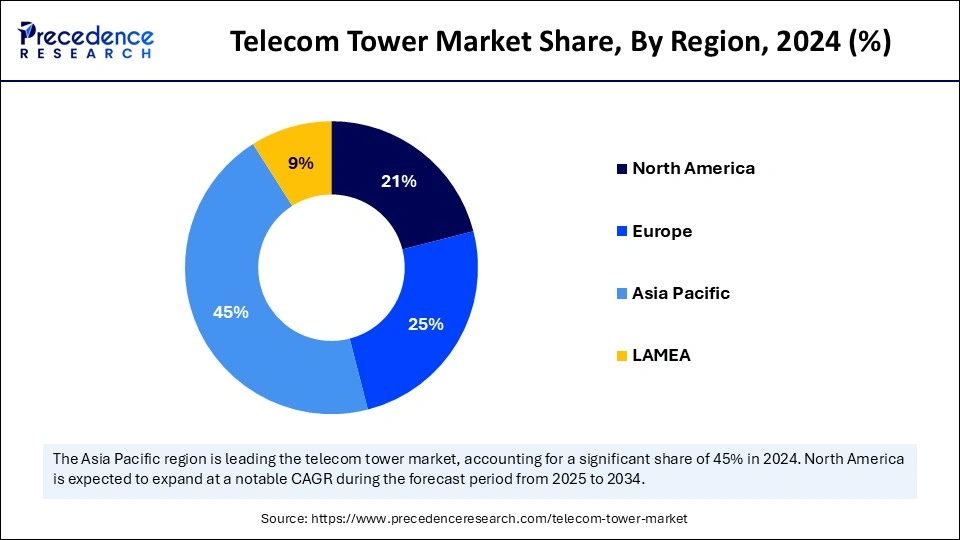
Europe is observed to grow at a considerable growth rate in the upcoming period. The regional market growth is attributed to the rising expansion of 5G infrastructure despite the difficulties brought on by regulations. Germany stands out as a market leader due to significant investments in next-generation telecom networks. There is a strong emphasis on high-tech telecom solutions to improve connectivity throughout the region. In addition, the rising modernization of existing towers to meet the demands of wireless networks supports market growth.
Due to the introduction of cutting-edge technologies like 5G and the growing need for improved network coverage, the telecom tower market is expanding quickly. The extensive use of smartphones and the ever-increasing demand for high-speed data services are also boosting the growth of the market. Important participants in this sector include Crown Castle International, a top supplier of shared communications infrastructure; SBA Communications, which has grown its portfolio through acquisitions; and American Tower Corporation, which leases tower space to major carriers. Other noteworthy businesses that are essential to the telecom infrastructure are Indus Tower Limited and China Tower Corporation. These businesses play a crucial role in assisting with developing and extending telecom networks to satisfy the rising demand for connectivity.
| Report Coverage | Details |
| Market Size by 2034 | USD 165.61 Billion |
| Market Size in 2025 | USD 67.87 Billion |
| Market Size in 2024 | USD 61.46 Billion |
| Market Growth Rate from 2025 to 2034 | CAGR of 10.42% |
| Dominating Region | Asia Pacific |
| Fastest Growing Region | North America |
| Base Year | 2024 |
| Forecast Period | 2025 to 2034 |
| Segments Covered | Deployment Type, Type, Installation, Application, and Regions |
| Regions Covered | North America, Europe, Asia-Pacific, Latin America, and Middle East & Africa |
5G Rollout
Telecom tower installations are booming because of the global rollout of 5G, which guarantees incredibly quick and seamless connectivity. In contrast to earlier generations, 5G needs a denser tower and a small cell network to operate efficiently. Crown Castle International is concentrating on small-cell deployments in urban areas, while American Tower Corporation is rapidly growing its tower portfolios to satisfy this demand. Indus Towers Limited is accelerating infrastructure development to facilitate more effective rollout of 5G services by telecom operators in India. The need for new towers is expected to increase in the near future as telecom companies compete to cover more areas.
The increasing demand for data drives the growth of the telecom tower market. With the rising adoption of online gaming, video streaming services, and hybrid work models, the world is seeing an unprecedented increase in mobile data demand. Telecom firms are being forced to increase network capacity and improve latency due to the enormous growth in data traffic. SBA Communications recently purchased thousands of communication sites to increase coverage and satisfy growing data demands. Meanwhile, China Tower Corporation is steadily growing its extensive portfolio, concentrating on densely populated urban areas. Established network providers such as Vodafone and Airtel are investing in tower-sharing models to meet the increasing consumer demands for reliable data and expedite network expansion.
Telecom towers are costly to build and even more expensive to maintain. For this reason, tower sharing is becoming more popular worldwide in which several operators share infrastructure to reduce costs and increase coverage more quickly. Independent tower firms, like SBA Communications, Helios Towers, and IHS Towers, have become major players in the telecom sector because of this trend. In Africa, for instance, Helios Towers is assisting telecom behemoths in growing into rural areas without worrying about the high infrastructure cost. Similarly, Indus Towers and ATC India rent out towers to several operators in India. American Tower and Crown Castle are advocating for co-location strategies that guarantee optimal profitability while providing dependable connectivity even in developed.
High Infrastructure Costs
High costs associated with building telecom towers hamper the growth of the telecom tower market. Substantial investments are required for land acquisition, equipment outsourcing, and construction to deploy telecom towers. Moreover, these towers require regular maintenance, which adds to operational costs. Infrastructure costs have increased even more because of the switch to 5G and small cell networks since higher frequencies require new infrastructure. This creates challenges for small operators. Additionally, the need for fiber optic connectivity is growing, so telecom operators must make additional investments. For high-speed 5G connections, businesses like Crown Castle International are concentrating on fiber deployment in addition to the tower, which significantly raises upfront costs. The high cost of infrastructure continues to be a significant obstacle to rapid expansion despite these efforts.
Finding good places for telecom towers in cities is getting harder because of space constraints and high land prices. Residents frequently oppose tower installation projects because of aesthetic concerns and the perceived health risks of electromagnetic radiation. The shared tower models and rooftop small cell deployment strategies used by Reliance Jio and Bharti Airtel in response have limited coverage capacity. Vodafone has also made a deal with space restrictions in Europe, where strict zoning regulations prohibit new tower installations. Telecom companies are using cutting-edge solutions like integrated street furniture and camouflaged towers to address these problems. Additionally, it is now more difficult to secure land for new towers due to the growth of smart cities and rapid urbanization, limiting the growth of the market.
Green Towers
Telecom tower operators are switching from diesel-powered locations to renewable energy sources as sustainability gains global attention. The adoption of renewable energy for powering telecom towers can reduce energy costs and carbon footprints and improve efficiency, creating immense opportunities in the telecom tower market. Businesses like Indus Tower in India and Helios Tower in Africa are setting the standard for solar-powered telecom infrastructure deployment, guaranteeing connectivity even in off-grid areas. Telecom operators who implement renewable solutions early will ensure long-term profitability and industry leadership in light of the growing demand for carbon-neutral telecom networks. Apart from the advantages of sustainability, green telecom towers lessen reliance on fossil fuels, increasing operational resilience to changes in energy prices. This change supports global climate goals while ensuring long-term cost stability.
Tower Leasing for Private 5G Networks
For high-security connectivity in manufacturing facilities, medical facilities, and logistics hubs, businesses are quickly implementing private 5G networks. There is a huge opportunity for tower leasing as businesses are putting up specialized 5G infrastructure instead of depending on public telecom networks. Companies like AT&T, Ericsson, and Nokia are already developing customized private 5G solutions for smart manufacturing and industrial automation. Companies that require secure, fast networks for cloud, AI, and IoT applications can lease towers from telecom tower operators. The demand for private 5G towers is expected to increase rapidly as sectors like logistics, healthcare, and automotive demand low-latency and high bandwidth solutions.
The shared infrastructure deployment segment dominated the telecom tower market with the largest share in 2024. This deployment permits several operators to share tower resources. This approach lowers costs, lessens the environmental impact, and speeds up network growth. Shared infrastructure is an affordable option, making it suitable for small operators. This model has been widely adopted by businesses such as American Tower Corporation, Indus Towers, and Bharti Infratel, who lease towers to telecom operators instead of having them construct their own. Telecom companies heavily use shared infrastructure to save financial resources and improve service coverage.
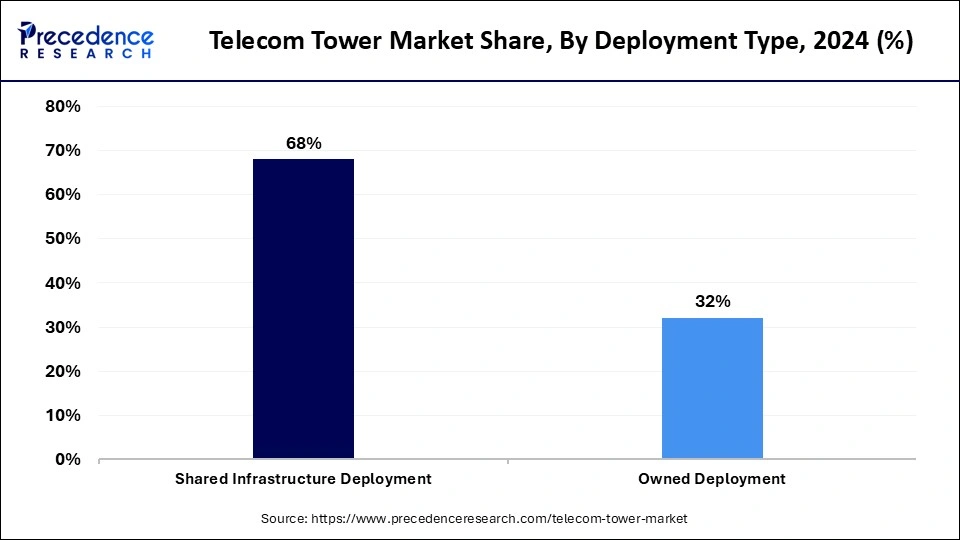
The owned deployment segment is expected to grow at the fastest rate in the market during the forecast period. Owned deployment enables businesses to manage their tower assets. This approach gives businesses more freedom and the possibility of making money by leasing to other operators. Moreover, owning tower assets enables telecom behemoths to implement the newest 5G and AI-powered technologies independently of outside parties.
The lattice towers segment dominated the telecom tower market in 2024. Lattice towers, which are distinguished by their angular open-frame construction, continue to be the most widely used because of their durability and ability to bear large loads. In regions that demand high structural strength, these towers are frequently utilized for telecom networks, broadcasting, and high-voltage transmission lines. Most telecom companies favor these towers due to their design, which improves wind resistance and enables hosting multiple antennas.
Lattice towers, which come in 3 and 4-legged designs, are appropriate for a range of environments. Leading Indian supplier Indus Towers keeps adding lattice towers to its inventory, assisting telecom companies in extending their networks into semi-urban and rural areas. Lattice towers will continue to be essential for providing dependable and extensive connectivity as 5G networks grow, especially in large-scale deployments.
The monopole towers segment is projected to grow rapidly in the coming years. These towers are gaining popularity, especially in urban areas, due to their sleek design and smaller footprints. These towers are perfect for places with limited space, like residential neighborhoods and city centers, where conventional lattice towers would not work. Telecom operators who want to quickly deploy networks choose them because they are also simpler and quicker to install.
Indian businesses such as Skipper Limited and Indus Towers have been at the forefront of using monopole towers that mimic plants and trees to blend in with urban environments. In addition to improving aesthetics, these structures use less energy, only 750 watts, as opposed to the 2- 5 kW needed for other towers. The need for monopole towers is predicted to increase as 5G rollouts necessitate denser tower networks, especially in urban areas.
The ground-based segment led the telecom tower market in 2024. Due to the stability and capacity to handle heavy equipment loads, the ground-based tower continues to be the most common installation technique. When space is not an issue, ground-based installation of towers is preferred, which is crucial for creating a wide network coverage. This installation is especially helpful in isolated rural areas with lots of available land.
The rooftop segment is expected to grow at the fastest rate in the market during the forecast period. In crowded urban areas with limited space, rooftop installations are more popular. Rooftop towers are an economical and effective solution because they build on existing buildings, removing the need for additional land acquisition. These configurations are essential for increasing coverage in densely populated areas and boosting signal strength in crowded areas.
The communication segment dominated the telecom tower market with a significant share in 2024, as telecom towers are the backbone of modern communications. Telecom towers are primarily used to support the transmission of voice, data, and multimedia services. Due to the growing use of 5G, cloud computing, and streaming services, there is an unprecedented demand for high-speed connectivity. Towers are essential to maintain network coverage and dependability, particularly in remote and underserved areas.
Businesses like Bharti Airtel are still making significant investments to expand their network infrastructure to satisfy the rising demand for communication services. In December 2024, Bharti Airtel and Ericsson signed a multibillion-dollar deal to expand the coverage of their 4G and 5G networks in India. The agreement calls for the installation of cutting-edge telecom equipment, which guarantees improved connectivity and faster internet speeds. Communication towers are central to the changing digital landscape as telecom operators worldwide prepare for 6G innovations.
The radar segment is anticipated to grow at the fastest rate in the market during the projection period. Telecom towers are increasingly used for radar applications, especially in weather monitoring, aviation, and defense. Real-time weather updates, air traffic control, and aircraft tracking depend on towers with radar. Radar technology is being incorporated into telecom infrastructure more and more by governments and private businesses to improve security and surveillance. Moreover, towers provide a suitable platform for radar installations.
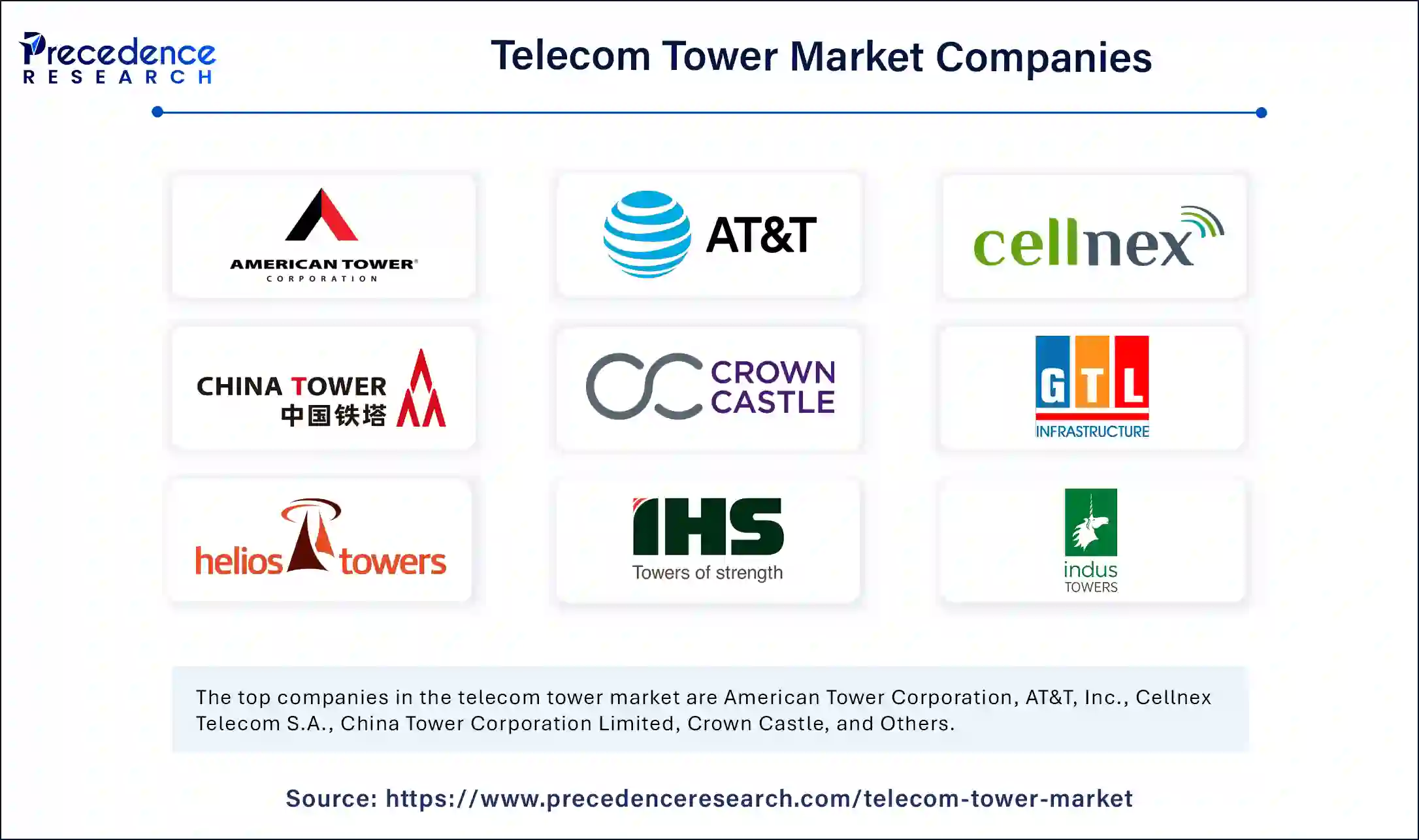
By Deployment Type
By Type
By Installation
By Application
By Region
For inquiries regarding discounts, bulk purchases, or customization requests, please contact us at sales@precedenceresearch.com
No cookie-cutter, only authentic analysis – take the 1st step to become a Precedence Research client
January 2025
January 2025
January 2025
January 2025